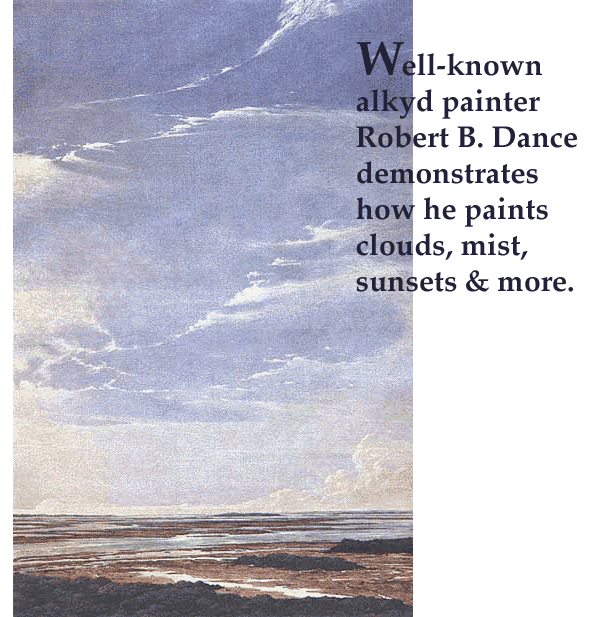
East
of Swansboro, 1979, alkyd, 20 X 13. This
scene near the coastal town of Swansboro is a study of land, water, cloud
and sky as they recede into the far distance. A number of glazes (20-30)
were used in this painting to imitate the effect of atmosphere on near
and distant objects.

 The
idea of trying to paint space and air will impress many as a nebulous
exercise at best, and I must admit that I feel it is one of the more
difficult aspects of painting. However, air exists as surely as
a rock or a figure , and its constant state of change affects the objects
we see both near and far. When looking at the work of the better
realist painters, one can almost stroll through their paintings and
breathe the air. Perhaps it is this seeming ability to walk into
these paintings that leads one to remember them as larger in size than
they actually are. I don't mean to imply that the air in the paintings
seem breathable because the works are so detailed and "magically" real.
I feel the quality of air in a painting has little to do with tightness
of technique. One can see good examples of paintings that seem
full of air in the works of the Impressionists whose use of the vibrant
color can be studied and applied to realism. The
idea of trying to paint space and air will impress many as a nebulous
exercise at best, and I must admit that I feel it is one of the more
difficult aspects of painting. However, air exists as surely as
a rock or a figure , and its constant state of change affects the objects
we see both near and far. When looking at the work of the better
realist painters, one can almost stroll through their paintings and
breathe the air. Perhaps it is this seeming ability to walk into
these paintings that leads one to remember them as larger in size than
they actually are. I don't mean to imply that the air in the paintings
seem breathable because the works are so detailed and "magically" real.
I feel the quality of air in a painting has little to do with tightness
of technique. One can see good examples of paintings that seem
full of air in the works of the Impressionists whose use of the vibrant
color can be studied and applied to realism.

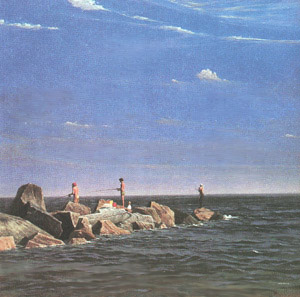 Blues off Fort Macon, 1981, alkyd, 24 X 24. My
sons and I have fished many times from this jetty at Fort Macon, near
Morehead City, North Carolina. The title refers to both the bluefish
the fisherman are catching and the blue sky and water. The line of the
ocean on the horizon is not a hard edge but a hazed one, achieved by
scumbling and glazing. Had this been painted as a hard edge, it would
not tend to recede into the distance.
Blues off Fort Macon, 1981, alkyd, 24 X 24. My
sons and I have fished many times from this jetty at Fort Macon, near
Morehead City, North Carolina. The title refers to both the bluefish
the fisherman are catching and the blue sky and water. The line of the
ocean on the horizon is not a hard edge but a hazed one, achieved by
scumbling and glazing. Had this been painted as a hard edge, it would
not tend to recede into the distance.
 To
be able to render atmospheric effects, perhaps one should know the air's
chemical makeup. However, I have always felt that too much dependence
on the scientific or mechanical aspects of art (such as mechanical perspective)
has a tendency to draw the life from art. Proper understanding
of such subjects is essential, but after one knows the facts behind
what is happening, it may be best to relegate that understanding to
the subconscious and think more about art. To
be able to render atmospheric effects, perhaps one should know the air's
chemical makeup. However, I have always felt that too much dependence
on the scientific or mechanical aspects of art (such as mechanical perspective)
has a tendency to draw the life from art. Proper understanding
of such subjects is essential, but after one knows the facts behind
what is happening, it may be best to relegate that understanding to
the subconscious and think more about art.
Air
consists of 78 percent nitrogen, 21 percent oxygen, 9 percent argon,
.03 percent carbon dioxide, traces of other gases, and a variable load
of water vapor. Air molecules intercept the short blue wavelengths
of the sun's radiation, thereby giving us our blue skies. The
lighter value of blue at the horizon is caused by light rays penetrating
a longer distance through dense lower air which contains water vapor,
dust, and varied gases. This effect often appears to have tints
of vermilion or alizarin crimson near the horizon. It is the water
vapor, plus varied particles of dust and smoke that affects the landscape
as we see it.

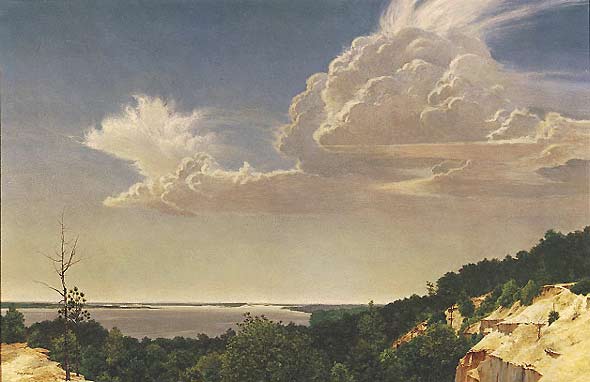

 The
effect of air on a landscape will obviously change with each minute,
day, and season. A humid day will find the air filled with minute
particles of water vapor. An extreme example of this would be
a dense fog, but this vapor can be seen on almost any day when viewing
distant landscapes. These particles of water vapor combine with
dust and tend to blur our vision of distant objects. They also
give distant objects a bluish or purplish cast and flatten their three-dimensional
quality. A good example would be a distant view of a mountain
range or islands off the coast of Maine which would tend to look flat
as in a stage set. This effect can be exaggerated as seen in many
watercolorists' backgrounds done with flat washes of granular color. The
effect of air on a landscape will obviously change with each minute,
day, and season. A humid day will find the air filled with minute
particles of water vapor. An extreme example of this would be
a dense fog, but this vapor can be seen on almost any day when viewing
distant landscapes. These particles of water vapor combine with
dust and tend to blur our vision of distant objects. They also
give distant objects a bluish or purplish cast and flatten their three-dimensional
quality. A good example would be a distant view of a mountain
range or islands off the coast of Maine which would tend to look flat
as in a stage set. This effect can be exaggerated as seen in many
watercolorists' backgrounds done with flat washes of granular color.
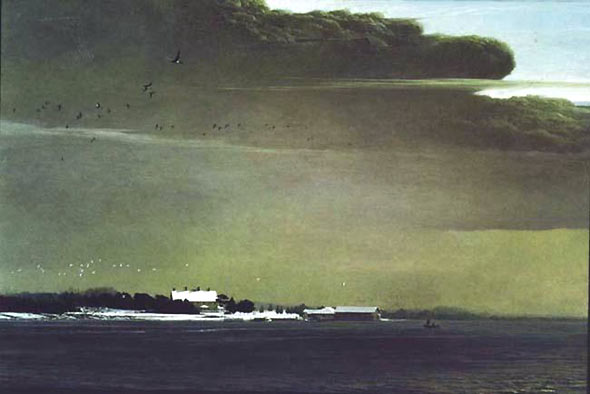
Snow
at Currituck, 1979, alkyd, 35 X 48. A
scene on the coastal sounds of North Carolina. Note how the land mass
loses definition to the right of the painting and in the extreme distance
at the center of the painting. Also, the wave action is more clearly
defined in the near distance than it is toward the bottom.

 As
we look through this layer of air, the objects closest to us will naturally
be seen with sharpness and clarity. But as objects recede, this layer
of atmosphere begins to haze the edges of distant objects. The
shapes seen to melt into the distant atmosphere. During the day,
this effect will change according to the dictates of temperature, humidity,
light, and wind-blown dust or smoke. Also to be considered is
the eye's focusing ability. When focused on nearby objects, the
eye loses its ability to focus on distant objects. This also results
in the illusion of depth. The paintings of the Luminists Frederic
Edwin Church or John Frederick Kensett clearly depict those phenomena.
Winslow Homer's The Artist's Studio in an Afternoon Fog and Thomas Eakins's
A Pair-oared Shell show these effects on background objects. As
we look through this layer of air, the objects closest to us will naturally
be seen with sharpness and clarity. But as objects recede, this layer
of atmosphere begins to haze the edges of distant objects. The
shapes seen to melt into the distant atmosphere. During the day,
this effect will change according to the dictates of temperature, humidity,
light, and wind-blown dust or smoke. Also to be considered is
the eye's focusing ability. When focused on nearby objects, the
eye loses its ability to focus on distant objects. This also results
in the illusion of depth. The paintings of the Luminists Frederic
Edwin Church or John Frederick Kensett clearly depict those phenomena.
Winslow Homer's The Artist's Studio in an Afternoon Fog and Thomas Eakins's
A Pair-oared Shell show these effects on background objects.
This
haze-like atmosphere can be rendered through the use of multiple transparent
or translucent glazes which imitate the actual haze found in nature.
Just as the real atmosphere mutes color and blurs edges, an applied
glaze can do the same in a painting. I have found that the addition
of a bit of white in the glaze will imitate the effect of the vapor
particles in the air. Thus, the underpainting should be a few
values darker than the final value desired. An atmospheric glaze might
consist of a bit of white, cobalt, and ochre ( I use alkyd paints) and
a good deal of medium ( in my case, Liquin). This mixture will
vary in color selection and transparency according to the effect desired.
Through this type of glazing, the value and color of distant objects
can be controlled in the most subtle of gradations. However, a
similar effect can also be accomplished by careful color and value selection
of opaque paint while trying to compensate for slight darkening or lightening
as the color dries. I personally feel that opaque color cannot
carry the same sense of depth seen in a glaze.
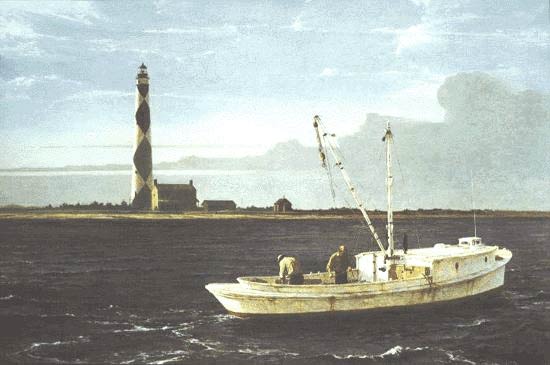
Cape
Lookout Morning , 1979, alkyd, 33 1/2 X 48. This
lighthouse, which has been standing since 1859, is one of the distinctive
landmarks along the outerbanks of North Carolina. A vibrancy is given
to the bluish-gray low-lying cloud mass by applying strokes of warm
and cool glazes in a subtle use of the Impressionists' technique. This
technique is more noticeable toward the right horizon where strokes
of a warm glaze made up of ochre and white are played against a cool
glaze of colbalt and white.

 Shadows
and reflected light also play a large part in creating the feeling of
air in a painting. In fact, a painting may seem devoid of air
until shadows are painted. A sense of three-dimensional space
can be achieved through the use of reflected light on objects. Shadows
and reflected light also play a large part in creating the feeling of
air in a painting. In fact, a painting may seem devoid of air
until shadows are painted. A sense of three-dimensional space
can be achieved through the use of reflected light on objects.
We
can learn how to imbue the air with a luminous quality by studying the
techniques of the Impressionists. The vibrant use of subtle strokes
of warm and cool color in sky areas will give the feeling of depth in
a sky. I will often apply stokes of warm and cool glazes over
a blue sky underpainting to achieve a vibrancy, particularly toward
the horizon as the sky lightens. The technique as I use it is
not as obvious as that used by the true Impressionist, but it is still
there.
A demonstration
of how I painted Columbus, Georgia appears below. This landscape
was commissioned by the W.C. Bradley Company of Columbus, Georgia.
I was free to select the subject matter for this painting and ended
up choosing a view of Columbus from a bridge over the Chattahoochee
River. On a very hot day, I did some pencil drawings from the
bridge and took a few color photographs to give me an idea of general
color. I feel that the color found in photographs is not the kind
of color I see, but it can give me an approximation in a subject as
involved as this painting.
The actual painting was done in my studio and measures 18" x 40".
I have often painted seascapes, and I was able to paint water again
in this subject by using the river ( which was quite low) as a major
element. You will notice that the eye is led into the distance
by the river itself and by form overlapping other forms. As these
forms overlap, they lose value, color intensity, and edges owing to
the humid air and haze. The extreme distance visible would be
represented by the hazy set-like line of trees beyond the distant bridge.
This line of trees and a few forms closer do not really have edges but
"melt" into the atmosphere surrounding them. The closer subjects
are fairly hard-edged, (showing) the figures exploring the river.
On
the day following my pencil drawing of this scene, there was a very
hard rain and the sandy islands in the river disappeared beneath the
water. I was pleased I had drawn the islands, as I feel they help
lead the eye into the painting and give a needed note of warm color.
Also, the figures could not have been included had the river been high.
The attempt to paint space and air into a painting can be a challenge
that summons up all one has learned about rendering perspective, form,
color, and edges. The greatest help, of course, is the careful
observation of nature itself and the awareness of how amazingly different
outdoor scenes can look over a 12-hour period.

 DEMONSTRATION:
'COLUMBUS,
GEORGIA' DEMONSTRATION:
'COLUMBUS,
GEORGIA'
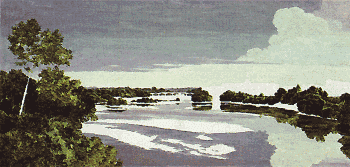
STEP ONE: Initially,
a detailed drawing was made from a bridge overlooking the city of Columbus,
Georgia. Then, a simple outline drawing was done on a gessoed panel
of untempered Masonite. This was followed by the first stage of underpainting
with rough-in of the tree forms, water, sky and clouds.
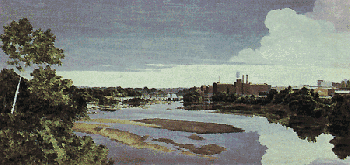
STEP TWO:
The basic underpainting. Some areas, such as the distant forms, were painted
a few values too dark, since I planned to paint over them with lighter
glazes which would represent atmospheric haze.
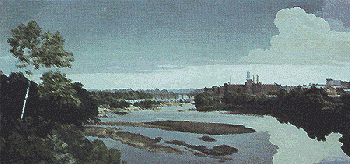
STEP THREE: I
continued working on the buildings and water tower structure; glazes were
applied to the background trees beyond the bridge.
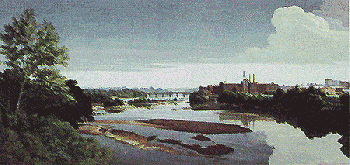
STEP FOUR: The
transition of blues from dark at the top to a lighter blue toward the
horizon was done by glazing over darker values in the underpainting.
As the glazes approached the bottom horizon, more white was added to
the glaze to achieve a lighter value. In this manner, very subtle values
in the transition from dark to light could be precisely controlled.

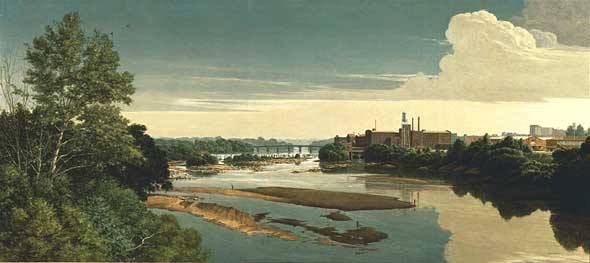
STEP
FIVE: The
completed painting: Columbus, Georgia, 1984, alkyd, 18 X 40. Click anywhere
on the painting above for a enlarged, detailed view.
Robert
B. Dance was born in Tokyo, Japan, and lives in Kinston, North Carolina,
with his wife Coleman. He is a graduate of the Philadelphia College
of Art where he studied under Henry C. Pitz.
Dance
is noted for his landscapes and seascapes, and his work has appeared
in American Artist on several occasions. His paintings have also
appeared in art publications here and abroad and in the following books:
40 Watercolorists and How They Work, Painting in Alkyd (both published
by Watson-Guptill Publications), and Things Invisible to See ( Advocate
Publishing Group). The North Carolina Watercolor Society has awarded
his work first prize in three different exhibitions.
His
work is in numerous corporate and private collections, including those
of the Northern Carolina Museum of Art, The Southeastern Center for
Contemporary Art has shown his work in several realist invitationals
and his work was included in the exhibit "Southern Realism," organized
bye the Mississippi Museum or Art.
Dance
has also tested new formula pigments for Winsor & Newton and has
been shown in their international presentation on alkyd pigments.

|

